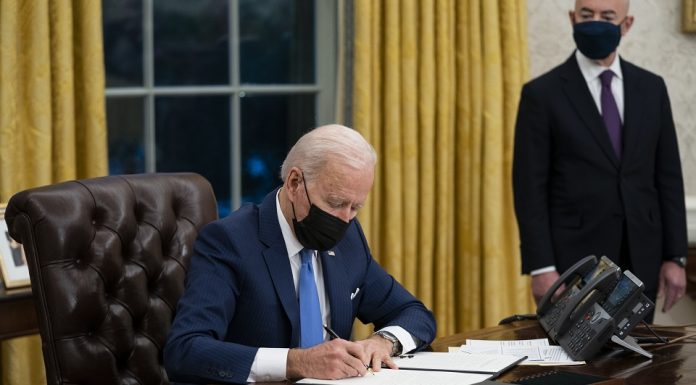(Headline USA) President Joe Biden, under political pressure, agreed to admit four times as many refugees this budget year as his predecessor did, but resettlement agencies concede the number actually allowed into the U.S. will be closer to the record-low cap of 15,000 set by former President Donald Trump.
Refugee advocates say they are grateful for the increase because it’s symbolically important to show the world the United States has open borders.
But they’re frustrated, too, because more refugees could have been admitted if Biden hadn’t dragged his feet.
“About 10,000 to 15,000 is what we’re expecting,” said Jenny Yang of World Relief, adding that Biden’s inaction for months after taking office in January was “definitely problematic.”
“That delay meant not being able to process refugee applications for four months. We weren’t able to rebuild for four months, so it really was unfortunate,” Yang said.
Biden first proposed raising the cap to 62,500 in February in a plan submitted to Congress, but then refused to sign off on it for two months before coming back April 16 and suggesting he was sticking with Trump’s target.
Democratic allies and refugee advocates lambasted him, saying he was reneging on his campaign promise in the face of bipartisan criticism over his handling of an increase in unaccompanied migrant children at the U.S.-Mexico border.
“To be clear: The asylum process at the southern border and the refugee process are completely separate immigration systems. Conflating the two constitutes caving to the politics of fear,” said Democratic Sen. Richard Blumenthal of Connecticut, a member of the Senate Judiciary Committee
Weeks later, on May 3, Biden raised the cap.
So far this year only about 2,500 refugees have arrived, with less than five months left before the fiscal year ends on Sept. 30.
More than 35,000 refugees have been vetted and approved to come to the United States, but thousands were disqualified under the strict eligibility criteria Trump established in October when he set the low cap.
By the time Biden expanded the eligibility, many health screenings and documents were no longer valid, according to resettlement agencies. And if someone had a baby during that time, then the entire family could be stalled.
Even under the best circumstances, it can take two months for each case to be updated.
Before the Trump administration’s drastic cuts, the United States had admitted more refugees each year than all other countries combined under a program now 41 years old.
The State Department recommended to the White House the ceiling be set at 62,500, officials said.
But a senior official familiar with Secretary of State Anthony Blinken’s thinking said it quickly became clear that the State Department offices responsible for refugee resettlement had been so gutted that they wouldn’t be able to process and absorb that number of refugees.
The official, who spoke on condition of anonymity because he was not authorized to speak publicly about the matter, described the situation as “aspiration meeting reality” and said Blinken reluctantly concluded that 62,500 wouldn’t be possible in the short term.
“It turned out there was even more damage done than we knew,” Blinken told reporters this month.
The Office of Refugee Resettlement also has been taxed by the jump in unaccompanied migrant children coming to the U.S. border, according to the administration.
Some $85 million was diverted from refugee resettlement money to help care for the children, government documents published by The New York Times show.
Biden did not want to promise something he wasn’t sure was possible, Blinken said.
“So we needed to take some time to make sure that the resources were in place, the people were in place, the programs were in place to actually receive refugees coming in,” he said.
The Trump administration had cut U.S. staff overseas who interview refugees by 117 officers. As a result, the number of interviews that were conducted fell by one-third in 2019 compared with those done in 2016 under the Obama administration.
That number fell off almost entirely in 2020 because of restrictions related to the coronavirus panic.
Due to travel restrictions in and out of refugee processing sites worldwide, the U.S. suspended refugee arrivals from March 19 to July 29 of last year except for emergency cases. Only 11,800 refugees were admitted in the 2020 fiscal year, the lowest number in the history of the program.
The administration is working on rehiring that staff and addressing the backlog, including by making it possible to conduct interviews by video teleconferencing instead of doing them in person, deputy State Department spokeswoman Jalina Porter said.
But it can take months to train new officers.
The government is also trying to tackle the layers of vetting put in place by the Trump administration, which brought the process nearly to a standstill and required, for instance, that refugees submit 10 years of addresses, something nearly impossible to do for people who have been on the move.
Biden has pledged money to expand the operations of resettlement agencies, which are paid by the federal government per refugee served. With the refugee numbers way down, the agencies were forced to close about 100 offices nationwide during the Trump administration.
Some agencies so far have only been able to cobble together a few dozen qualified people after losing their experienced staff.
They also need time to reestablish their partnerships with landlords, employers and others who have helped refugees get established in communities, a challenge with increasing housing prices and other added constraints related to the pandemic.
The “sad truth” Biden warned when he finally set the target at 62,500 is that goal won’t be achieved.
Instead, the administration and advocates are working to revamp the program by 2022 when Biden has promised to raise the ceiling to 125,000.
Adapted from reporting by the Associated Press.

